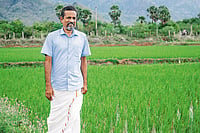When Moushumi Majumdar, a resident of Chittaranjan Park in Delhi, was widowed, she was left with the responsibility of raising a young son. Over the years, the one thing that the septuagenarian found solace in was music as she continued to learn Indian light music. Unable to fit into the iPod mindset, she stuck to her old cassettes and CDs to play her favourite tunes from Rabindra Sangeet to old Hindi film songs.
Three years ago, when her son gifted her Carvaan, a digital music player with preloaded songs—Bengali, in Majumdar’s case—on her birthday, she knew she had got an inseparable companion.
Launched in 2017 by Saregama India, the country’s oldest music label, without much fanfare, Carvaan, available with songs in Hindi, Tamil, Punjabi, Telugu, Bengali, Marathi and Malayalam, became an instant success in an era where music, of all kinds and genres, is widely available across audio streaming platforms.
The product, which looks like a modern cousin of the old-school radio transistor, knobs and all, made some wonder why a veteran music company would design something that is at least 10 years behind in technology. Logically, it should have been a complete reject. Instead, the chunky box with 5,000 preloaded songs sold like hot cakes when India was witnessing a digital boom with internet data packs.
There was clearly an audience for Carvaan, and tapping into that audience, Saregama launched several versions of it with its increasing popularity.
However, with Covid-19-induced lockdowns forcing millions of uninitiated to migrate to the digital world and them becoming comfortable there, the fate of Carvaan seems a bit unclear.
Setting the Tone
The launch of Carvaan involved well-researched positioning, extensive surveys and calculated risks.

It started off with the company wanting to use its vast repertoire of Indian music comprising more than 1,17,000 songs in 14 languages. In 2015, it hired an agency which conducted surveys in 23 cities across India to understand what music lovers really wanted. The research revealed that consumers were looking for convenience. “We knew that we had to create an entirely new category of products that would bring convenience to our customers. We had to create a device that played their favourite songs at the click of a button,” says Avarna Jain, vice chairperson, Saregama.
It took the company about 14 months to finalise the product, which was designed in-house—from the way it looked and felt to its content. “We did go through a few iterations but realised that convenience was the key. If you see our versions of Carvaan, they do not have a screen that can give you 2,000 options. They have buttons and knobs that remind you of the good old transistor days. To scroll through, you have a knob to go from one song to the other. It was this look and feel that people missed about a transistor radio or a basic cassette player,” says Jain. Carvaan essentially ticks three boxes—ease of use, convenience and nostalgia—she adds.
The current buyers and consumers of Carvaan fall in two different age groups—also because of the smart positioning of the product as a gift option. The buyer—Majumdar’s son—is the younger generation that buys the product for their parents or grandparents while the consumer—Majumdar—is mostly over 40-45 years old who connects with the retro value and ease of Carvaan.
In its first year, the company sold 3.87 lakh units of Carvaan, a figure that swelled up to 9.04 lakh units in 2018–19. The spectacular success of the product came as a pleasant surprise for Saregama. “Because we were catering to the 40-plus age group and not necessarily the Gen Z or the millennials at that point of time, the nostalgia value hit the right chord with people. We launched it pan India and, later on, added it to ecommerce and also launched our own website. But the larger sales kept coming from offline stores,” says Jain.
While launching the various upgrades and versions of Carvaan, the company ensured that the product continues to cater to the changing consumer patterns and behaviour.
In September, it launched Carvaan Mobile, its first-ever keypad mobile packed with 1,500 preloaded songs. The phone, with a digital camera, dual SIM, 8 GB memory card, wireless FM and other features, comes in two sizes—1.8-inch screen and 2.4-inch screen. All the preloaded songs are divided into categories of artists, like Kishore Kumar, Asha Bhosle, Lata Mangeshkar, Mohammed Rafi, etc., as well as moods, like happy, sad and more. It has been designed keeping in mind the elderly who love music but prefer keypad phones. Currently available in Hindi and Tamil, the company has plans to launch it in regional languages, depending upon the response it generates in the market.
At the centre of every new product that Saregama launches, it claims, is data-driven insight. The company gets data from nearly 134 partners, including YouTube, Gaana and telecom companies that offer songs as caller tunes, along with the company’s own apps and services. Saregama’s music is consumed through over 1.1 billion consumption points a month across channels and tracks. This data is fed into an analytics software that gives an understanding of consumption patterns, helping the company build products that consumers want.
Being Tuned in
While things were seemingly going well, the fear of Carvaan losing relevance started looming over Saregama after Covid-19 forced the world to adopt the digital realm faster.
Sales, too, saw a major dip. From 7.41 lakh units in 2019–20, the sales number more than halved in 2020–21 to 3.44 lakh units. With the calming down of the pandemic and physical reopening of stores, the numbers slightly improved to 4.01 lakh units in 2021–22, but it is still a far cry from its pre-Covid numbers. “The future will be different, I am sure, but in the pre-Covid world, just being able to take our music to so many people was the biggest reward for us,” says Jain.
The vice chairperson also understands the change in consumer behaviour. “People have adapted to technology beautifully. Since the consumption pattern has changed so much, we will have to wait and see what we have in store. Also, we have a few products that will come to the market very soon, but everything will hinge on consumer pattern and behaviour,” she adds.
The company will also have to take the young demography of the country into serious consideration, as making products that have little relevance to almost a third of the population (less than 44 years) could be suicidal. A 2017 report from Morgan Stanley Research suggests that 70% of total household incomes are contributed by millennials or those born after 1982.
Saregama has started heading in that direction. To bring the younger audience into its consumer bracket, the Carvaan Mini, also the highest selling model for Saregama, was launched by the company in 2017. It was sold as a device that youngsters in the 22–35 years age bracket could use as a Bluetooth speaker while it could also become a shared gadget at homes due to its FM feature and preloaded songs. Carvaan Mini Kids, another popular variant, was also introduced in 2020 with English and Hindi rhymes, bedtime stories and more.
“We are investing in new content and will soon have something for the next gen as well,” says Jain. Nonetheless, she maintains confidence in Carvaan and, interestingly, adds, “Digital platforms focus on technology, and we focus on anthropology.”





























